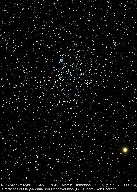L(6x10min), RGB(3x5min; 2x2 bin)
IDAS Light Pollution Filter
Takahashi FS-102 @ f/6 (625kb)
Luminance Frames Only (645kb)
9 October 2005


| IC1318/LDN889/Do10 L(6x10min), RGB(3x5min; 2x2 bin) IDAS Light Pollution Filter Takahashi FS-102 @ f/6 (625kb) Luminance Frames Only (645kb) 9 October 2005 |
 |
 |
| IC5067/5070 (The Pelican
Nebula) L(6x10min), RGB(3x5min; 2x2 bin) Takahashi FS-102 @ f/6 (712kb) 28 August 2005 |
 |
| IC5146 (The Cocoon
Nebula)/B168 L(6x10min), RGB(4x5min; 2x2 bin) Takahashi FS-102 @ f/6 (837kb) 3 September 2005 |
 |
| NGC281 L(7x10min), RG(3x5min; 2x2 bin) IDAS Light Pollution Filter Takahashi FS-102 @ f/6 (692kb) 9 October 2005 |
 |
| NGC221(M32)/NGC224 (M31) L(4x10min), RG(3x5min; 2x2 bin), B(2x5min; 2x2 bin) Takahashi FS-102 @ f/6 (451kb) 4 September 2005 |
 |
| NGC598 (M33, The Pinwheel
Galaxy) L(4x10min), RGB(3x5min; 2x2 bin) Takahashi FS-102 @ f/6 (711kb) 6 August 2005 |
 |
| NGC884/NGC869 (The Double
Cluster) L(6x10min), RGB(4x5min; 2x2 bin) Takahashi FS-102 @ f/6 (772kb) 4 September 2005 |
 |
| NGC884/NGC869 (The Double
Cluster) LRGB(3x10min) Takahashi FS-102 @ f/6 (729kb) 27 November 2005 |
 |
| NGC884/NGC869 (The Double
Cluster) LRGB(3x10min) Minus Violet Filter Takahashi FS-102 @ f/6 (785kb) 27 November 2005 |
 |
| NGC896 L(6x10min), RGB(3x5min; 2x2 bin) Takahashi FS-102 @ f/6 (707kb) 4 December 2005 |
 |
| NGC1976 (M42)/NGC1982 (M43) LRGB(3x10min), RGB(3x10min) Takahashi FS-102 @ f/6 (364kb, 300kb) 27 November 2005 |
 |
 |
| NGC2068 (M78) L(32x5min), RGB(10x5min; 2x2 bin) Takahashi FS-102 @ f/6 (986kb) The night was very windy with poor seeing, and the guide star was moving substantially on the CCD. 21 January 2007 |
 |
| NGC2437 (M46)/NGC2438 LRGB(10x5min); 3 iterations of LR on L Takahashi FS-102 @ f/6 (1.5mb) The red color at the edge of the planetary nebula, NGC2438, compares well with the image by Jim Misti (processed by Rob Gendler) taken with a 32" Ritchey-Chretien. http://www.robgendlerastropics.com/M46JM.html First image taken with AP1200 GOTO mount. 12 March 2007 |
 |
| NGC3034 (M82)/NGC3031 (M81) L(6x10min), RGB(3x5min; 2x2 bin) Takahashi FS-102 @ f/6 (440kb) 25 February 2006 |
 |
| NGC4406 (M86)/Virgo Cluster L(16x10min), RGB(7x5min) Takahashi FS-102 @ f/6 (305kb) Luminance Frames Only (422kb, 507kb) 45 galaxies down to 20th magnitude are visible! 29 April 2006 |
 |
 |
 |
| NGC5194 (M51)/NGC5195 L(10x5min), RGB(4x5min) Takahashi FS-102 @ f/6 (330kb) Luminance Frames Only (200kb) 26 May 2006 |
 |
 |
| NGC5457 (M101)/NGC5477 L(22x5min), RGB(11x5min) Takahashi FS-102 @ f/6 (376kb) Luminance Frames Only (181kb, 264kb) 30 May 2006 |
 |
 |
 |
| NGC6205 (M13)/NGC6207 LRGB(2x10min) Takahashi FS-102 @ f/6 (652kb) 3 September 2005 |
 |
| NGC6514 (M20, The Trifid
Nebula) L(3x10min), RGB(3x5min; 2x2 bin) Takahashi FS-102 @ f/6 (601kb) 3 August 2005 |
 |
| NGC6523 (M8, The Lagoon
Nebula) L(5x10min), RGB(3x5min; 2x2 bin) Takahashi FS-102 @ f/6 (546kb) 3 August 2005 |
 |
| NGC6618 (M17, The Swan Nebula) L(4x10min), RGB(2x5min; 2x2 bin) Takahashi FS-102 @ f/6 (746kb) 31 July 2005 |
 |
| NGC6853 (M27, The Dumbbell
Nebula) L(3x10min), RGB(2x5min; 2x2 bin) Takahashi FS-102 @ f/6 (830kb) 30 July 2005 |
 |
| NGC6888 (The Crescent
Nebula) LRGB(3x10min) Takahashi FS-102 @ f/6 (1.1mb) 6 August 2005 |
 |
| NGC6960 (The Veil
Nebula) L(6x10min), RGB(3x5min; 2x2 bin) Takahashi FS-102 @ f/6 (1.1mb) 3 August 2005 |
 |
| NGC6992/6995 (The Veil
Nebula) LRGB(3x10min), RGB(1x5min) Takahashi FS-102 @ f/6 (1.0mb) 6 August 2005 |
 |
| Pickering's Triangular Wisp (This is an unnumbered component of the Veil Nebula) L(6x10min), RGB(3x5min; 2x2 bin) Takahashi FS-102 @ f/6 (1.0mb) 3 September 2005 |
 |
| NGC7000 (The North American Nebula) L(6x10min), RGB(3x5min; 2x2 bin) Takahashi FS-102 @ f/6 (680kb) 28 August 2005 |
 |
| NGC7293 (The Helix Nebula) L(24x5min), RGB(6x5min; 2x2 bin) Takahashi FS-102 @ f/6 (524kb) 23 September 2006 |
 |